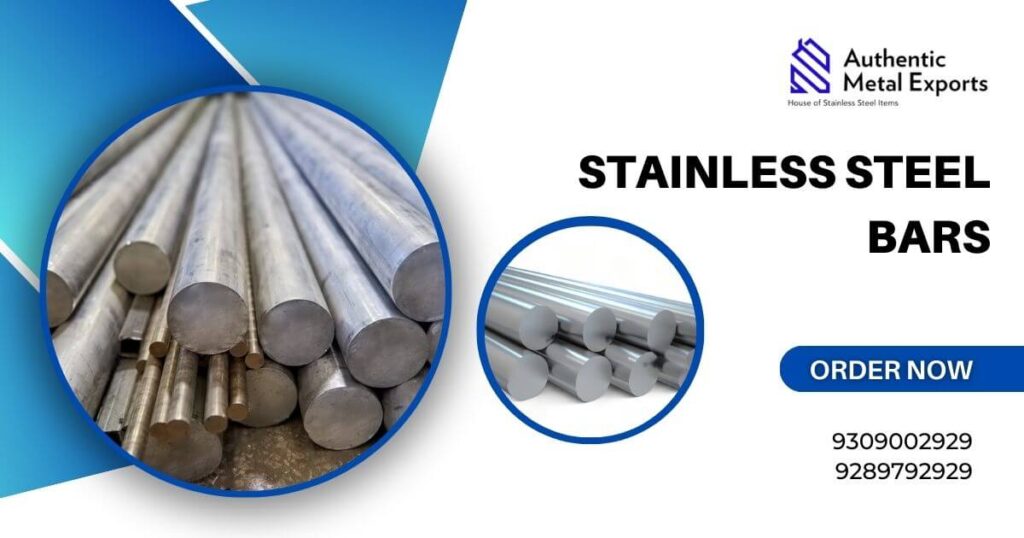In today’s world, where sustainability is at the forefront of every industry, finding eco-friendly solutions has become imperative. When it comes to construction and manufacturing, stainless steel bars are emerging as a sustainable solution for a greener future.
With their unique properties, stainless steel bars offer numerous advantages, making them a top choice for environmentally conscious businesses. Not only are these bars incredibly durable and resistant to corrosion, but they are also 100% recyclable, making them a sustainable alternative to traditional materials.
Furthermore, stainless steel bars require minimal maintenance, reducing the need for harmful chemicals and minimizing the environmental impact. From architectural marvels to everyday products, stainless steel bars are revolutionizing the way we build and manufacture, providing a durable, long-lasting, and sustainable solution that aligns perfectly with our commitment to preserving the planet.
Join the movement towards a greener future with stainless steel bars and make a positive impact on both your business and the environment.
Stainless steel bars offer a range of environmental benefits that contribute to a greener future.
Firstly, stainless steel is a highly durable material that can withstand harsh conditions and extreme temperatures . This durability ensures that structures and products made with stainless steel bars have a longer lifespan, reducing the need for frequent replacements and minimizing waste.
Additionally, stainless steel is resistant to corrosion, which means it does not require any additional protective coatings or treatments. This eliminates the need for harmful chemicals that can pollute the environment during the manufacturing and maintenance processes.
Moreover, stainless steel bars are 100% recyclable. This means that at the end of their lifespan, they can be melted down and transformed into new stainless steel products without any loss in quality.
Recycling stainless steel reduces the demand for raw materials and saves energy, making it an environmentally friendly choice.
Furthermore, stainless steel is non-toxic and does not release any harmful substances into the environment, ensuring that it is safe for both human health and the ecosystem.
In conclusion, the environmental benefits of stainless steel bars are significant. Their durability, resistance to corrosion, and recyclability make them a sustainable choice for construction and manufacturing industries
By choosing stainless steel bars, businesses can minimize waste, reduce the need for harmful chemicals, and contribute to a greener future.
Advantages of Using Stainless Steel Bars in Construction
Stainless steel bars offer numerous advantages when it comes to construction projects.
Firstly, their exceptional strength makes them suitable for a wide range of structural applications.
Whether it’s for building bridges, high-rise buildings, or even small-scale projects, stainless steel bars provide the necessary strength and stability.
Additionally, stainless steel bars have a high load-bearing capacity, allowing for the construction of lightweight structures without compromising on strength.
Another advantage of stainless steel bars is their resistance to corrosion. Unlike other construction materials, stainless steel does not rust, ensuring the longevity and durability of structures even in harsh environments.
This resistance to corrosion also eliminates the need for frequent maintenance and repairs, reducing costs and minimizing the environmental impact.
Furthermore, stainless steel bars offer design flexibility. They can be easily shaped, bent, and welded to create unique and intricate architectural designs.
This versatility allows architects and designers to push the boundaries of creativity while still ensuring structural integrity.
Stainless steel bars also have an aesthetically pleasing appearance, making them an ideal choice for projects that require both functionality and beauty.
o.
To sum up, the advantages of using stainless steel bars in construction are undeniable. Their strength, resistance to corrosion, and design flexibility make them a preferred choice for architects, engineers, and construction professionals.
By incorporating stainless steel bars into construction projects, businesses can create sustainable and visually appealing structures that stand the test of time.
Applications of Stainless Steel Bars in Various Industries
Stainless steel bars find applications in a wide range of industries due to their unique properties and versatile nature. Let’s explore some of the key industries where stainless steel bars are commonly used:
1. Construction
Stainless steel bars are extensively used in the construction industry for various applications such as reinforcing concrete, structural supports, and architectural finishes.
Their strength, durability, and resistance to corrosion make them an ideal choice for building bridges, tunnels, high-rise buildings, and other infrastructure projects.
2. Automotive
Stainless steel bars are utilized in the automotive industry for their corrosion resistance and high strength.
They are commonly used in exhaust systems, suspension components, and structural parts. Stainless steel bars ensure longevity and performance, even in the harshest conditions.
3. Food and Beverage
Stainless steel bars are widely used in the food and beverage industry due to their hygienic properties. They are used to manufacture food processing equipment, storage tanks, and transportation containers.
Stainless steel bars offer easy cleaning, resistance to bacterial growth, and compliance with food safety regulations.
4. Medical
Stainless steel bars play a crucial role in the medical industry. They are used to manufacture surgical instruments, orthopedic implants, and medical equipment.
Stainless steel’s biocompatibility, corrosion resistance, and strength make it an ideal material for medical applications.
5. Energy
Stainless steel bars are used in the energy sector for their resistance to high temperatures and corrosion. They are commonly used in power plants, oil and gas refineries, and renewable energy projects.
Critical components in these sectors are reliable and long-lasting thanks to stainless steel bars.
These are just a few examples of the industries where stainless steel bars are extensively used. From construction to automotive, food and beverage to medical, and energy to manufacturing, stainless steel bars offer unparalleled performance and sustainability across various sectors.
Sustainability Practices in Stainless Steel Bar Production
The production of stainless steel bars involves several sustainability practices that contribute to a greener future. Let’s explore some of these practices:
1. Recycled Content
Stainless steel bars often contain a significant amount of recycled content. By using recycled stainless steel scrap in the production process, the demand for virgin raw materials is reduced, conserving natural resources and energy.
2. Energy Efficiency
Stainless steel bar production facilities strive to improve energy efficiency by implementing advanced technologies and processes. This includes using energy-efficient machinery, optimizing production schedules, and recycling waste heat generated during manufacturing.
3. Water Conservation
Water is a valuable resource, and stainless steel bar production facilities aim to minimize water consumption through various techniques. This includes recycling and reusing water within the production process, implementing water-saving measures, and treating wastewater before it is discharged.
4. Waste Management
Stainless steel bar production facilities have robust waste management systems in place to minimize waste generation and maximize recycling. This includes segregating different types of waste, recycling scrap materials, and responsibly disposing of any non-recyclable waste.
5. Emissions Reduction
To minimize the environmental impact, stainless steel bar production facilities employ measures to reduce emissions. This includes implementing air pollution control technologies, optimizing production processes to minimize greenhouse gas emissions, and monitoring and reporting on emissions.
These sustainability practices ensure that the production of stainless steel bars is carried out in an environmentally responsible manner.
By choosing stainless steel bars produced using these practices, businesses can contribute to a greener future and support sustainable manufacturing processes.
Recycling and Reusing Stainless Steel Bars
One of the key advantages of stainless steel bars is their 100% recyclability. At the end of their lifespan, stainless steel bars can be recycled and transformed into new stainless steel products without any loss in quality.
Let’s explore the process of recycling and reusing stainless steel bars:
1. Collection
Stainless steel bars are collected from various sources such as construction sites, manufacturing facilities, and end-of-life products. These bars are then sorted based on their size, shape, and composition.
2. Melting
The collected stainless steel bars are melted down in large furnaces to form a liquid metal. The melting process requires high temperatures to ensure the stainless steel reaches its molten state.
3. Purification
The molten stainless steel undergoes purification to remove any impurities. This is done through various refining processes such as vacuum degassing, argon oxygen decarburization, and electro-slag remelting.
4. Casting
The purified stainless steel is then cast into various forms such as bars, sheets, or coils, depending on the desired end product. This process ensures the recycled stainless steel retains its properties and meets the required specifications.
5. Manufacturing
The recycled stainless steel bars are then used in various manufacturing processes to create new products. These products can range from construction materials to kitchen appliances, automotive components to medical devices.
By recycling and reusing stainless steel bars, businesses can reduce the demand for virgin raw materials, conserve energy, and minimize waste. This not only contributes to a greener future but also supports a circular economy where resources are used efficiently and sustainably.
How to Choose the Right Stainless Steel Bars for Your Project
When choosing stainless steel bars for your project, several factors need to be considered. To assist you in making the best decision, take into account the following:
1. Grade
Stainless steel bars are available in different grades, each with its own unique properties. Consider the specific requirements of your project and select a grade that offers the desired strength, corrosion resistance, and other necessary characteristics.
2. Size and Shape
Stainless steel bars come in various sizes and shapes, including round, square, and hexagonal. Determine the dimensions and shape that best suit your project’s requirements.
3. Surface Finish
Stainless steel bars can have different surface finishes, such as polished, brushed, or matte. Consider the desired aesthetic and functional requirements of your project when choosing the surface finish.
4. Supplier
Choose a reputable supplier that specializes in stainless steel bars. A reliable supplier will provide high-quality products, offer technical support, and ensure timely delivery.
By considering these factors, you can select the right stainless steel bars for your project, ensuring optimal performance, durability, and sustainability.
Future Trends in Stainless Steel Bar Production and Sustainability
The future of stainless steel bar production is focused on further enhancing sustainability and reducing environmental impact. Following are some important trends to look out for:
1. Advancements in Recycling Technologies
Ongoing research and development are focused on improving recycling technologies for stainless steel bars. This includes developing more efficient melting and refining processes, as well as exploring new methods for separating and sorting stainless steel scrap.
2. Eco-friendly Manufacturing Processes
Stainless steel bar production facilities are continuously working towards reducing energy consumption, minimizing emissions, and optimizing resource efficiency.
This includes adopting cleaner energy sources, implementing waste-to-energy technologies, and implementing closed-loop systems to minimize water consumption.
3. Circular Economy Initiatives
The stainless steel industry is increasingly embracing circular economy principles. This involves designing products for recyclability, promoting the use of recycled content, and establishing closed-loop supply chains to ensure stainless steel bars are recycled and reused effectively.
These trends indicate a promising future for stainless steel bar production, where sustainability and environmental responsibility are at the forefront.
By embracing these trends, the stainless steel industry can continue to provide sustainable solutions for a greener future.
Authentic Metal Exports – Stainless Steel Shop In Delhi
Address:– 1/10, Asaf Ali Road, Opposite Kamla Market, Ajmeri Gate, New Delhi- 110002
Call Now: 9309002929
Chat on WhatsApp:- 9309002929, 9289792929






